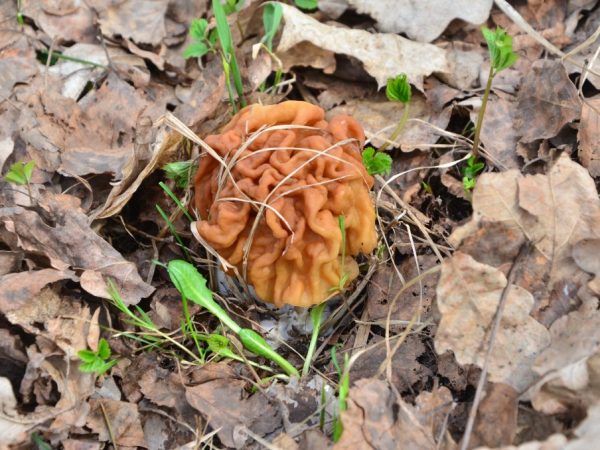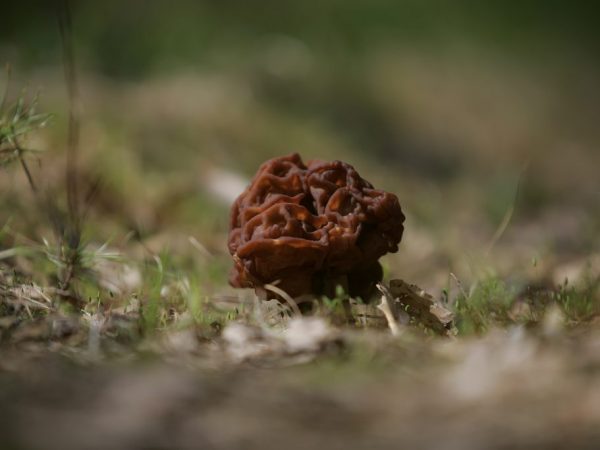Mushroom genus Lines
Often, line mushrooms are considered inedible due to their unpleasant appearance and are left in the forest. But this species is worth the attention of both experienced and novice mushroom pickers, because with proper processing, its taste is not inferior to those characteristic of other conditionally edible mushrooms.

Stitching mushroom variety
Appearance stitching
Description of the appearance of the line:
- The cap is wrinkled, covered with large convolutions (resembles the surface of a walnut kernel or brain). The color is dark brown or reddish brown, the shape is irregular. Sizes - up to 15 cm.
- The leg is thick, irregular in shape, hidden behind the convolutions of the cap. Usually white or pink, empty inside.
- The pulp breaks easily, smooth, with a pleasant smell.
The stitching mushroom looks like a morel. The last representative is a delicacy with a conical head, porous surface and fibrous pulp.
Collect lines on sandy soils. They are saprophytic organisms. They prefer to grow under coniferous trees, they do not form mycorrhiza with them. They grow in small groups. It is a spring species, the first fruiting bodies appear in April-May. In the subtropics, it bears fruit until mid-autumn.
Irina Selyutina (Biologist):
The genus Strochok, or Giromitra, belongs to the Helwell family and is characterized at the microscopic level by the fact that 1-3 large drops of fat are always present in their ascospores. The number of cores in each such dispute is 4 - this number is strictly fixed.
The lines are ascomycetes, that is, marsupials. Spores form on the entire surface of the cap. We can say that it is, as it were, turned upside down outward in comparison with cap mushrooms.
Mushroom species
Mycologists distinguish 4 subspecies, of which only 2 are edible:
- giant morel;
- from. ordinary (Ukrainian "emergency");
- from. autumn;
- from. beam (s. pointed, or s. pointed).
Poisonous species
- FROMcommon track: now this species is classified as poisonous. It contains gyromitrin in the pulp. It is a dangerous toxin for the body that does not break down even at high temperatures and drying. Mushrooms are considered dangerous fruits growing in Germany, but there have been cases of poisoning in Russia as well.
Irina Selyutina (Biologist):
Until now, mycologists are breaking spears on the question of why the lines collected in Germany are more poisonous than those collected in other European countries and Russia. It is believed that the content of gyromitrin (a specific toxin of the lines) depends either on the strain of the fungus or on the conditions of development. Back in the late 1960s and early 1970s of the twentieth century, mycological studies carried out in Germany showed that 1 kg of fresh fruit bodies of stitches contains 1676 mg of gyromitrin, which caused severe poisoning. But in other countries, the lines are eaten without any consequences for the body. For your information. In terms of its effect on the body, gyromitrin is quite comparable to the effect of toxins from the pale grebe.
- Autumn line: on the verge of edibility and poisonousness are representatives of this species. Outwardly, it differs from other types: its hat resembles a folded or crumpled sheet of paper or puff pastry. The color of the cap is red or yellow-brown. The mushroom is not recommended to be consumed raw, boiling does not destroy the toxin, however, the toxicity decreases after drying for 3-4 weeks.
Edible species
Until now, mycologists argue whether the fruit bodies of the fungus are edible. In the West, even the giant and the beam are considered poisonous. Domestic mushroom pickers classify them as conditionally edible.
- The line is giant: hats of representatives of this species can reach a diameter of 30 cm. It is also called gigantic. The leg is almost completely hidden behind the cap.
- Sheaf stitching: the size of the apothecia (fruiting body) reaches sizes up to 15 cm. The cap has 2 sharp upper corners and 2 lower ones, lowered downward. The texture of the cap is the same as that of all fruiting bodies of the genus.
Individuals growing on the territory of Russia are less toxic in comparison with representatives of the same species, but growing on the territory of European countries. Types of stitching gigantic and with. bunch is pre-soaked in water for several days, then boiled in boiling water for 15 minutes. As a result, hazardous substances are removed from the fruiting bodies.
The danger is that the poisonous and edible species of these mushrooms have the same fruiting period, therefore, when collecting, each fruiting body must be carefully considered. Edible species, due to their saturation with important chemical components, are beneficial to humans.
Beneficial features

There are many useful substances in mushrooms
Stitching mushrooms are useful, like other forest gifts. The pulp contains useful compounds such as pectin, chitin. Apothecia also contains vitamins A, PP, group B, micro- and macroelements:
- calcium;
- magnesium;
- sodium;
- phosphorus;
- manganese;
- copper.
Such a set of vitamins and minerals is useful for vision, hair and nails. They note beneficial properties for the cardiovascular system, immunity, nervous system, and gastrointestinal tract. Oleic acid (22 mg per 100 g) is useful for intestinal motility.
Pectin has a cleansing effect. Thanks to chitin, the pulp takes a long time to digest, quickly satisfies the feeling of hunger. Forest species are low in calories - 30 kcal per 100 g. The main part of the pulp is water. Mushrooms of the Strochok genus are rich in proteins.
Contraindications
Stitching mushrooms are not recommended for children under 7 years old, the elderly, pregnant and lactating women. In limited quantities, people with problems of the gastrointestinal tract, liver, kidneys, as well as with individual intolerance to the components of mushrooms, eat forest gifts.
Contraindicated for use inedible ordinary line and p. autumn. The toxins present in them cause food poisoning. Other safety rules:
- Edible fruiting bodies collected in contaminated places (along highways, industrial zones, etc.) are considered unsafe.
- You should pick mushrooms yourself or buy in special stores.
- It is dangerous to buy a view from the hands: often poisonous mushrooms are passed off as delicacy lines.
Application
The stitching mushroom is used in cooking and traditional medicine. Although fruiting bodies do not have a high taste, they are prepared as the first spring mushroom.
The medicine
Traditional medicine recommends using alcohol tincture from a line for a number of diseases:
- arthritis;
- osteochondrosis;
- radiculitis;
- rheumatism;
- neuralgia;
- myopia, cataracts;
- myositis;
- diseases of the pancreas.

Mushroom tincture strengthens the immune system
The tincture is prepared from 30 g of dried pulp and 0.5 l of vodka. The mixture is infused in the refrigerator for 14 days. Then it is rubbed into painful joints, wrapped in warm clothes. The procedure is carried out no more than 3 times a day.
The tincture is carefully consumed inside: it is diluted in a 1: 1 ratio with honey and drunk 5 ml per day. The course to strengthen the immune system lasts 2 weeks.If a rash appears in the application sites or there are other symptoms of non-perception, be sure to consult a doctor.
Cooking
Fruit bodies are not consumed in their raw form. As part of safety, they should be boiled twice for 15 minutes or soaked in water and then boiled. Attention! You need to boil the lines in a large amount of water. The broth is not used after boiling. After that, the trophies are pickled, salted, fried, stewed in sour cream or with cream.
- The species tolerates deep freezing and drying well:
- The pulp is considered safe after 4 weeks of drying.
- At temperatures from -18 ° C, the workpiece is stored for up to a year.
- Fresh mushrooms are stored in the refrigerator for up to 3 days.
Before processing, the mushrooms are carefully sorted out and washed.
Growing methods
Mushroom stitches do not have a high taste, they actively bear fruit in forests, so there is no need to cultivate them at home. But reproduction is possible through mycelium and spores on the site or in a closed mycelium.
Conclusion
The edibility of mushrooms of the Strochok genus is still under discussion. The common and autumnal fungus are poisonous, and the giant and bunchy are conditionally edible fruits. They are used after digestion and soaking, stored in the form of dry or frozen blanks. The mushroom does not differ in high taste, but it is valuable among the people as the first spring species that can diversify the menu after winter.



